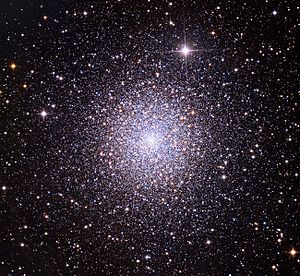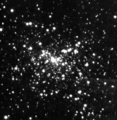Messier 15
| Messier 15 | |
|---|---|
 Deep Broadband (RGB) image of M15 | |
| Observation data (J2000 epoch) | |
| Class | IV[1] |
| Constellation | Pegasus |
| Right ascension | 21h 29m 58.33s[2] |
| Declination | +12° 10′ 01.2″[2] |
| Distance | 35.69 ± 0.43 kly (10.944 ± 0.131 kpc)[3] |
| Apparent magnitude (V) | 6.2[4] |
| Apparent dimensions (V) | 18′.0 |
| Physical characteristics | |
| Mass | 5.6×105[5] M☉ |
| Radius | ~88 ly[6] |
| VHB | 15.83 |
| Metallicity | = –2.37[7] dex |
| Estimated age | 12.0 Gyr[8] |
| Notable features | steep central cusp |
| Other designations | NGC 7078, GCl 120[9] |
Messier 15 or M15 (also designated NGC 7078 and sometimes known as the Great Pegasus Cluster) is a globular cluster in the constellation Pegasus. It was discovered by Jean-Dominique Maraldi in 1746 and included in Charles Messier's catalogue of comet-like objects in 1764.[citation needed] At an estimated 12.5±1.3 billion years old, it is one of the oldest known globular clusters.[10]
Characteristics
[edit]M 15 is about 35,700 light-years from Earth,[3] and 175 light-years in diameter.[11] It has an absolute magnitude of −9.2, which translates to a total luminosity of 360,000 times that of the Sun. Messier 15 is one of the most densely packed globulars known in the Milky Way galaxy. Its core has undergone a contraction known as "core collapse" and it has a central density cusp with an enormous number of stars surrounding what may be a central black hole.[12]
Home to over 100,000 stars,[11] the cluster is notable for containing a large number of variable stars (112) and pulsars (8), including one double neutron star system, M15-C. It also contains Pease 1, the first planetary nebula discovered within a globular cluster in 1928.[13][14] Just three others have been found in globular clusters since then.[15]
Amateur astronomy
[edit]At magnitude 6.2, M15 approaches naked eye visibility under good conditions and can be observed with binoculars or a small telescope, appearing as a fuzzy star.[11][14] Telescopes with a larger aperture (at least 6 in. (150 mm)) will start to reveal individual stars, the brightest of which are of magnitude +12.6. The cluster appears 18 arc minutes in size (three tenths of a degree across).[11] M15 is around 4° WNW of the brightest star of Pegasus, Epsilon Pegasi.[14]
X-ray sources
[edit]Earth-orbiting satellites Uhuru and Chandra X-ray Observatory have detected two bright X-ray sources in this cluster: Messier 15 X-1 (4U 2129+12) and Messier 15 X-2.[16][17] The former appears to be the first astronomical X-ray source detected in Pegasus.
Gallery
[edit]-
The central square arcminute of M15 imaged using the lucky imaging technique
-
Map showing the location of M15
-
M15 photographed by HST. The planetary nebula Pease 1 can be seen as a small blue object to the upper left of the core of the cluster.
See also
[edit]References
[edit]- ^ Shapley, Harlow; Sawyer, Helen B. (August 1927). "A Classification of Globular Clusters". Harvard College Observatory Bulletin. 849 (849): 11–14. Bibcode:1927BHarO.849...11S.
- ^ a b Goldsbury, Ryan; et al. (December 2010). "The ACS Survey of Galactic Globular Clusters. X. New Determinations of Centers for 65 Clusters". The Astronomical Journal. 140 (6): 1830–1837. arXiv:1008.2755. Bibcode:2010AJ....140.1830G. doi:10.1088/0004-6256/140/6/1830. S2CID 119183070.
- ^ a b Bhardwaj, Anupam; Rejkuba, Marina; Sloan, G. C.; Marconi, Marcella; Yang, Soung-Chul (2021). "Optical and Near-infrared Pulsation Properties of RR Lyrae and Population II Cepheid Variables in the Messier 15 Globular Cluster". The Astrophysical Journal. 922 (1): 20. arXiv:2108.11388. Bibcode:2021ApJ...922...20B. doi:10.3847/1538-4357/ac214d. S2CID 237304172.
- ^ "Messier 15". SEDS Messier Catalog. Retrieved 21 July 2024.
- ^ Marks, Michael; Kroupa, Pavel (August 2010). "Initial conditions for globular clusters and assembly of the old globular cluster population of the Milky Way". Monthly Notices of the Royal Astronomical Society. 406 (3): 2000–2012. arXiv:1004.2255. Bibcode:2010MNRAS.406.2000M. doi:10.1111/j.1365-2966.2010.16813.x. S2CID 118652005. Mass is from MPD on Table 1.
- ^ distance × sin( diameter_angle / 2 ) = 88 ly radius
- ^ Boyles, J.; et al. (November 2011). "Young Radio Pulsars in Galactic Globular Clusters". The Astrophysical Journal. 742 (1): 51. arXiv:1108.4402. Bibcode:2011ApJ...742...51B. doi:10.1088/0004-637X/742/1/51. S2CID 118649860.
- ^ Koleva, M.; et al. (April 2008). "Spectroscopic ages and metallicities of stellar populations: validation of full spectrum fitting". Monthly Notices of the Royal Astronomical Society. 385 (4): 1998–2010. arXiv:0801.0871. Bibcode:2008MNRAS.385.1998K. doi:10.1111/j.1365-2966.2008.12908.x. S2CID 17571531.
- ^ "M 15". SIMBAD. Centre de données astronomiques de Strasbourg. Retrieved 2006-11-16.
- ^ O'Malley, Erin M.; Gilligan, Christina; Chaboyer, Brian (April 2017). "Absolute Ages and Distances of 22 GCs Using Monte Carlo Main-sequence Fitting". The Astrophysical Journal. 838 (2): 162. arXiv:1703.01915. Bibcode:2017ApJ...838..162O. doi:10.3847/1538-4357/aa6574. S2CID 11852378.
- ^ a b c d "M 15". astropix.
- ^ Gerssen J, van der Marel RP, Gebhardt K, Guhathakurta P, Peterson RC, Pryor C (2003). "Evidence for an intermediate-mass black hole in the globular cluster M 15. II. Kinematic analysis and dynamical modeling". Astronomical Journal. Hubble Space Telescope. 125 (1): 376–377. arXiv:astro-ph/0210158. Bibcode:2003AJ....125..376G. doi:10.1086/345574. S2CID 118948032.
- ^ Cohen, J.G.; Gillett, F.C. (1989). "The peculiar planetary nebula in M 22" (PDF). Astrophysical Journal. 346: 803–807. Bibcode:1989ApJ...346..803C. doi:10.1086/168061. S2CID 119770028.
- ^ a b c O'Meara, Stephen James; Levy, David H. (1998), Deep-Sky Companions: The Messier Objects, Cambridge University Press, p. 74, ISBN 978-0521553322.
- ^ "more". SEDS.org. Messier 15.
- ^ Forman W; Jones C; Cominsky L; Julien P; Murray S; Peters G (1978). "The fourth Uhuru catalog of X-ray sources". Astrophysical Journal Supplement Series. 38: 357. Bibcode:1978ApJS...38..357F. doi:10.1086/190561.
- ^ White NE; Angelini L (2001). "The discovery of a second luminous low-mass X-ray binary in the globular cluster M15". Astrophysical Journal Letters. 561 (1): L101–5. arXiv:astro-ph/0109359. Bibcode:2001ApJ...561L.101W. doi:10.1086/324561. S2CID 18877294.
External links
[edit]- Messier 15, SEDS Messier pages
- Messier 15, Galactic Globular Clusters Database page
- Globular Cluster Photometry With the Hubble Space Telescope. V. WFPC Study of M15's Central density Cusp
- Wikisky.org SDSS image of M15
- Gretton, Roy; Gray, Meghan. "M15 – Globular Cluster". Deep Sky Videos. Brady Haran.
- Messier 15 on WikiSky: DSS2, SDSS, GALEX, IRAS, Hydrogen α, X-Ray, Astrophoto, Sky Map, Articles and images
- REDIRECT Template:NGC objects:7001-7500
This page is a redirect. The following categories are used to track and monitor this redirect:
|

![{\displaystyle {\begin{smallmatrix}\left[{\ce {Fe}}/{\ce {H}}\right]\end{smallmatrix}}}](https://wikimedia.org/api/rest_v1/media/math/render/svg/4c0821bd80891e071c08e7c7ee8e022baedf522c)



